Red light at 660nm penetrates up to 6mm into your scalp tissue, reaching deeper than other wavelengths to supercharge hair growth. This specific wavelength boosts ATP production in follicle cells while triggering nitric oxide synthesis, which dilates blood vessels and enhances nutrient delivery to your hair roots. You'll benefit from reduced inflammation, increased collagen production, and prolonged anagen growth phases – resulting in thicker, healthier hair. Clinical studies show impressive results: up to 37% increased hair growth in women and 35% in men. The molecular magic behind these transformative effects reveals an even more fascinating story.
The Science Behind 660nm Light
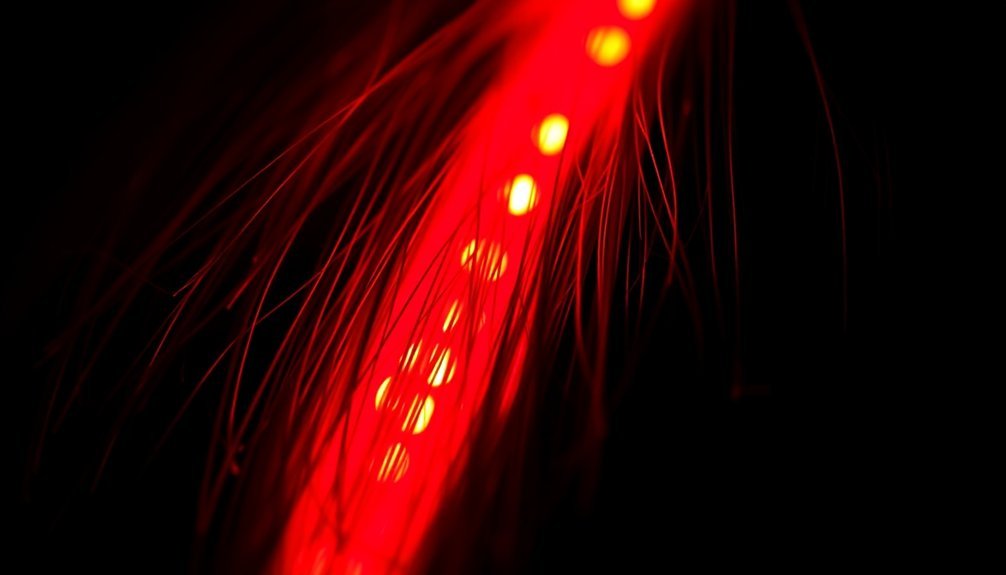
Light at 660 nanometers represents a powerful wavelength in the red spectrum that penetrates deep into human tissue, making it particularly effective for therapeutic applications.
When this specific wavelength interacts with your scalp and hair follicles, it triggers several biological responses that promote healing and regeneration. The therapy is particularly effective for those with androgenic alopecia conditions.
You'll find that 660nm light substantially enhances blood flow to your scalp, delivering essential nutrients and oxygen to hair follicles. This wavelength also stimulates cellular processes, improving collagen deposition and tissue repair at the follicular level. It's particularly effective because it falls within the ideal therapeutic range of 630-700 nanometers.
What sets 660nm apart is its proven ability to reduce inflammation while promoting healing without any invasive procedures. Clinical trials have consistently shown that this wavelength is both safe and effective for hair growth applications.
The light's interaction with your tissue depends on factors like duration, intensity, and distance from the source. While you can access this technology through various devices, it's important to consult a healthcare practitioner before starting treatment. They'll help you determine the right exposure time and frequency for your specific needs.
Cellular Mechanisms of Hair Growth
When you use 660nm light therapy on your scalp, it directly enhances ATP production in the hair follicle cells' mitochondria, providing more energy for active hair growth.
The light's wavelength repairs mitochondrial DNA damage, which helps maintain healthier cellular function throughout the hair growth cycle. This process is especially crucial during the anagen growth phase, when cells are rapidly proliferating and differentiating.
The therapy activates dormant stem cells in your hair follicles through the Notch signaling pathway, promoting the development of new hair shaft cells from keratinocytes.
ATP Production and Enhancement
Understanding ATP production in hair follicles proves critical for healthy hair growth, as this cellular energy source powers everything from cell division to phase shifts in the hair growth cycle. Your hair's growth cycle, particularly during the active anagen phase, depends heavily on ATP production through oxidative phosphorylation in the follicles. This process is enhanced by ALDH2 activation, which significantly increases ATP generation in follicular cells.
The 660nm red light wavelength enhances ATP production through a fascinating mechanism: it photodissociates nitric oxide from the QIV complex in your cell's electron transport chain. This process effectively removes a natural "governor" that typically limits ATP production under low-oxygen conditions. You'll find this enhancement particularly important during the shift from telogen (rest) to anagen (growth) phases.
What makes this wavelength especially effective is its ability to boost ATP production more quickly than traditional treatments like minoxidil. When you're using red light therapy, it's stabilizing your mitochondria by improving the ADP/ATP ratio. This enhancement directly supports your dermal papilla's energy needs, powering the complex signaling processes that orchestrate hair growth.
For those experiencing hair loss, this ATP-boosting mechanism offers a promising pathway for supporting natural hair growth cycles.
Mitochondrial DNA Repair
Deep within your hair follicles, mitochondrial DNA repair mechanisms play a critical role in maintaining healthy hair growth and preventing age-related hair loss. Your mitochondrial DNA is particularly vulnerable to oxidative damage due to its location near the inner mitochondrial membrane, and when repair mechanisms fail, it can lead to hair follicle dysfunction.
Mitochondrial DNA repair isn't just a simple process – it's a complex system that primarily relies on base excision repair to process oxidative damage. When these repair pathways don't function properly, damage accumulates in your mitochondrial DNA, accelerating the aging process in your hair follicles. Studies show that depleted mtDNA content directly contributes to hair thinning and loss in experimental models. This damage can prevent your follicles from producing normal hair shafts, ultimately leading to hair loss.
The good news is that restoring mitochondrial function can reverse these effects. Research has shown that techniques like mitochondrial transplantation, particularly using Pep-1-mediated delivery, can effectively promote hair growth and reduce aging markers. Understanding these repair mechanisms has opened new doors for hair loss treatment, as maintaining your mitochondrial DNA's integrity is essential for sustaining healthy hair growth throughout your life.
Stem Cell Activation
Beyond mitochondrial repair, hair growth depends heavily on stem cell activation within your follicles. Your hair's growth cycle relies on specialized cells called dermal papilla cells (DPCs), which trigger stem cells in the follicle bulge to transform into hair-producing cells. When these stem cells activate, they migrate to the hair matrix and become progenitor cells, ultimately forming new hair shafts.
| Growth Phase | Stem Cell Activity | Key Signals |
|---|---|---|
| Anagen | High proliferation | HGF, EGF, VEGF |
| Catagen | Reduced activity | TGF-β1 |
| Telogen | Dormancy | Low growth factors |
| Early Anagen | Activation begins | Jagged 1/Notch |
| Late Anagen | Peak production | IGF-1, b-FGF |
The process is orchestrated by regulatory T cells (Tregs) that activate the Notch signaling pathway through the Jagged 1 protein. This activation triggers a cascade of growth factors, including HGF, EGF, b-FGF, and VEGF, which stimulate your follicle's stem cells. These molecular signals work together to maintain the cyclical nature of hair growth, ensuring continuous regeneration of your hair follicles through proper stem cell activation and differentiation.
Blood Flow and Follicle Health
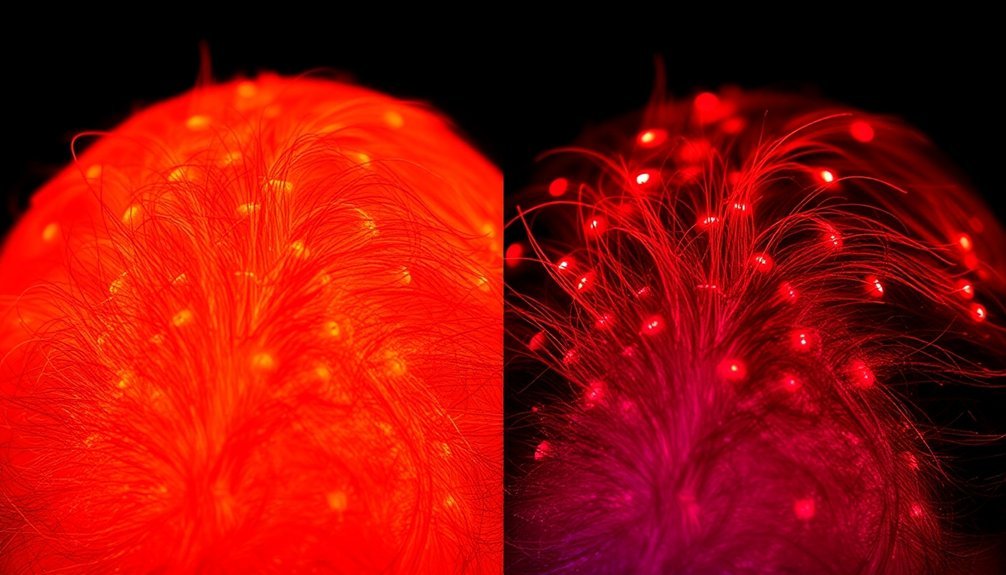
Red light therapy at 660nm wavelength creates a powerful one-two punch for hair growth by boosting blood flow and revitalizing follicle health. When the light penetrates your scalp, it triggers biochemical changes in your cellular photoreceptors, leading to enhanced microvascular circulation and improved nutrient delivery to your hair follicles.
The light energy stimulates your mitochondria to produce more ATP, while simultaneously increasing nitric oxide synthesis. This combination dilates your blood vessels and improves circulation, ensuring your follicles receive the oxygen and nutrients they need to thrive.
You'll benefit from prolonged anagen phase cycles, which means your hair grows for longer periods before entering its resting phase.
At the cellular level, 660nm light activates your keratinocyte stem cells and dermal papilla cells through cytokine and growth factor induction. This process isn't just about blood flow – it's also reducing inflammation in your scalp, creating ideal conditions for healthy hair growth.
Clinical studies back this up, showing significant improvements in hair density and thickness when using devices that emit 660nm wavelength light consistently.
DHT Reduction Through Light Therapy
Red light therapy at 660nm naturally blocks DHT production by inhibiting the 5-α reductase enzyme that converts testosterone to DHT.
You'll find this therapy particularly effective when using dual wavelengths of 620nm and 660nm together, as they work synergistically to reduce DHT levels through increased nitric oxide production.
The light's hormonal impact extends beyond simple DHT blocking, as it simultaneously promotes better blood flow and cellular rejuvenation in your hair follicles.
Natural DHT Blocking Mechanisms
Understanding how light therapy naturally blocks DHT production marks a significant breakthrough in hair loss prevention. When your scalp is exposed to dual wavelengths of 620nm and 660nm visible light, it triggers a natural cascade of events that effectively reduces DHT levels.
The key player in this process is nitric oxide (NO), which your epithelial cells produce in response to these specific light wavelengths.
Your body's natural DHT-blocking mechanism becomes supercharged when you use light therapy. The 660nm wavelength, in particular, penetrates your scalp tissue to stimulate the dermal papilla while simultaneously inhibiting 5-α reductase, the enzyme responsible for converting testosterone to DHT.
This dual action not only prevents further hair loss but also promotes new growth by reversing follicle miniaturization.
You'll find this natural approach particularly effective because it doesn't rely on synthetic chemicals. Instead, it works with your body's innate processes.
The combination of red and near-infrared light enhances your scalp's ability to regulate DHT production naturally, while the synergistic effect of dual wavelengths maximizes NO production, giving you a powerful, natural solution for maintaining healthy hair growth.
Light Therapy's Hormonal Impact
Through innovative light therapy protocols, your body's hormonal responses undergo significant changes, particularly in how it manages DHT production. When you expose your scalp to 660nm wavelength light, it triggers the release of nitric oxide from nitrosothiols and nitrosylated proteins, which directly inhibits the 5-α reductase enzyme responsible for converting testosterone to DHT.
You'll find that dual-wavelength therapy, combining 620nm and 660nm, is particularly effective. These wavelengths work together to stimulate nitric oxide and reactive oxygen species production, creating a powerful DHT-blocking effect in your scalp's epithelial cells.
The treatment doesn't just target DHT; it also improves your microvascular circulation and reduces inflammation.
Clinical evidence supports these benefits, with FDA-cleared devices showing significant results in reducing DHT levels while promoting hair growth. When you use light therapy devices that emit these specific wavelengths, you're not just treating surface-level symptoms – you're addressing the hormonal root cause of hair loss.
The combination of improved blood flow, reduced inflammation, and decreased DHT production creates an ideal environment for your hair follicles to thrive.
Comparing Wavelength Effectiveness
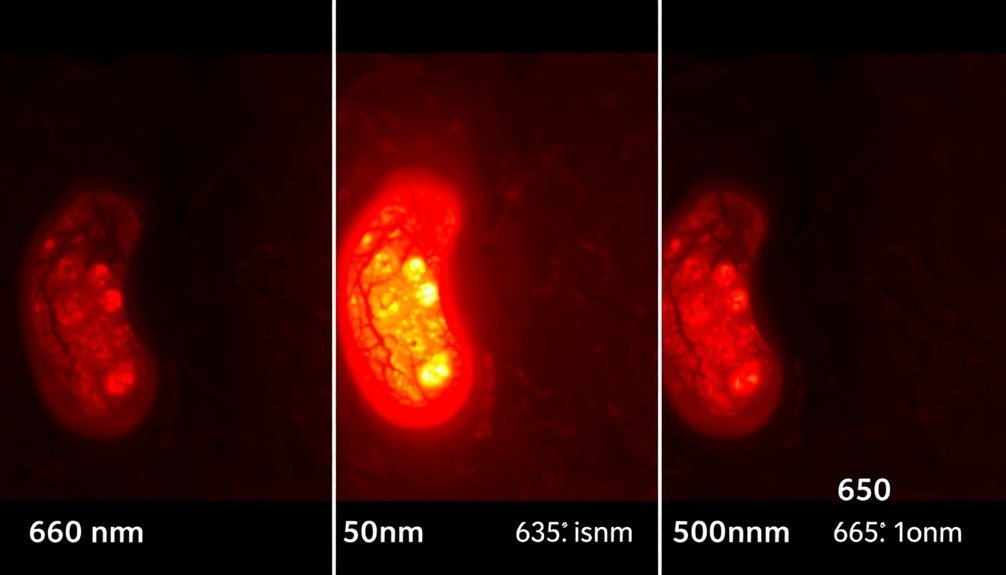
In light therapy for hair growth, 660nm and 850nm wavelengths serve distinct but complementary purposes. While 660nm light targets surface-level hair follicles to boost hair density and thickness, 850nm near-infrared light penetrates deeper into the tissue, addressing underlying scalp conditions and promoting thorough healing.
You'll notice these key differences in how each wavelength works:
- 660nm light directly stimulates mitochondria in hair follicles, increasing cellular energy and ATP production
- 850nm NIR penetrates deeper, making it ideal for treating muscle tissue and deep scalp issues
- 660nm excels at surface-level improvements in hair density and follicle health
- 850nm enhances blood flow and reduces inflammation in deeper tissue layers
When you're looking to maximize hair growth benefits, combining both wavelengths offers the most extensive approach. The 660nm wavelength's ability to boost surface-level cellular metabolism pairs perfectly with 850nm's deep-penetrating properties.
This synergistic effect means you're targeting hair growth from multiple angles – both at the surface where new growth begins and deep within the tissue where healing and regeneration occur. With consistent use, this combination can notably improve both hair density and overall scalp health.
Treatment Duration and Expected Results
Successful light therapy treatment for hair growth relies on carefully timed sessions and proper delivery methods. You'll need to commit to 15-20 minute sessions every other day during the initial phase, then scale back to 2-3 times weekly for maintenance once you see improvements.
The effectiveness of your treatment depends on consistent application and proper device positioning. You'll calculate your dose by multiplying power density and time, with effective doses ranging from 1 to 60 J/cm². While you won't feel much during treatment beyond a mild warming sensation, the long-term results are significant.
Clinical studies show impressive results when you stick to the protocol. You can expect a 17% increase in hair count and density, along with a 13.91% boost in mean hair thickness. Some studies even report up to 35% increase in hair growth over 16 weeks. However, you'll need patience – significant improvements typically become visible after six months of consistent use.
Terminal hair count and density improvements of 17.45% and 16.61% respectively demonstrate why maintaining a regular treatment schedule is essential for achieving the best results.
Clinical Studies and Research Data
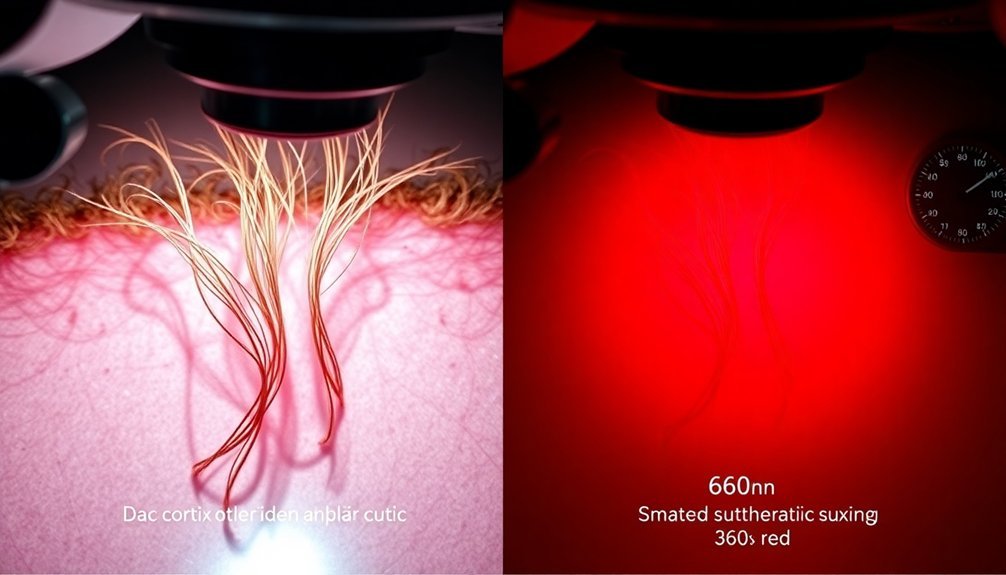
Numerous clinical studies consistently validate the effectiveness of 660nm red light therapy for hair growth through rigorous scientific protocols.
The research, conducted across multiple centers with double-blind, randomized controls, demonstrates significant improvements in hair count and density. You'll find compelling evidence showing a 26.3 hairs/cm² increase after just 16 weeks of treatment using dual-wavelength therapy at 620nm and 660nm.
What makes these studies particularly reliable is their methodical approach to measuring results. Researchers tracked patients aged 18-65 with various types of hair loss, using advanced imaging techniques and strict compliance monitoring through Bluetooth-connected apps.
The data shows consistent improvements across different hair loss classifications, from early to moderate stages.
- Clinical trials report 17-17.45% increases in hair density with daily 10-minute treatments
- Studies confirm the therapy's safety with zero treatment-related adverse events
- Research verifies that 660nm specifically targets and prolongs the anagen (growth) phase
- Results span across diverse patient groups with Fitzpatrick Skin Types I-IV
These findings are particularly significant because they're backed by peer-reviewed evidence and sham-controlled studies, eliminating potential placebo effects and confirming the treatment's genuine efficacy.
Home Treatment Vs Professional Options
With the scientific evidence firmly establishing 660nm red light therapy's effectiveness, you'll want to think about whether home treatment or professional services better suit your needs.
Home treatments offer significant cost savings over time and unmatched convenience, allowing you to maintain consistent therapy sessions without scheduling appointments. You'll find various device options, from panels to caps, that you can customize to your specific needs and use whenever it fits your schedule.
Professional treatments, while more expensive, provide expert guidance and supervision from trained specialists who can customize your treatment plan and monitor your progress. You'll have access to more powerful equipment in a clinical setting, which might lead to faster results.
Professional facilities also maintain strict hygiene standards and follow safety protocols, reducing your risk of complications.
Your choice ultimately depends on your priorities. If you value convenience and cost-effectiveness, home treatment devices offer a practical solution. However, if you prefer professional oversight and don't mind the higher costs, clinical treatments provide advanced technology and expert care.
Both options can deliver effective results when used properly and consistently.
Safety Profile and Treatment Guidelines
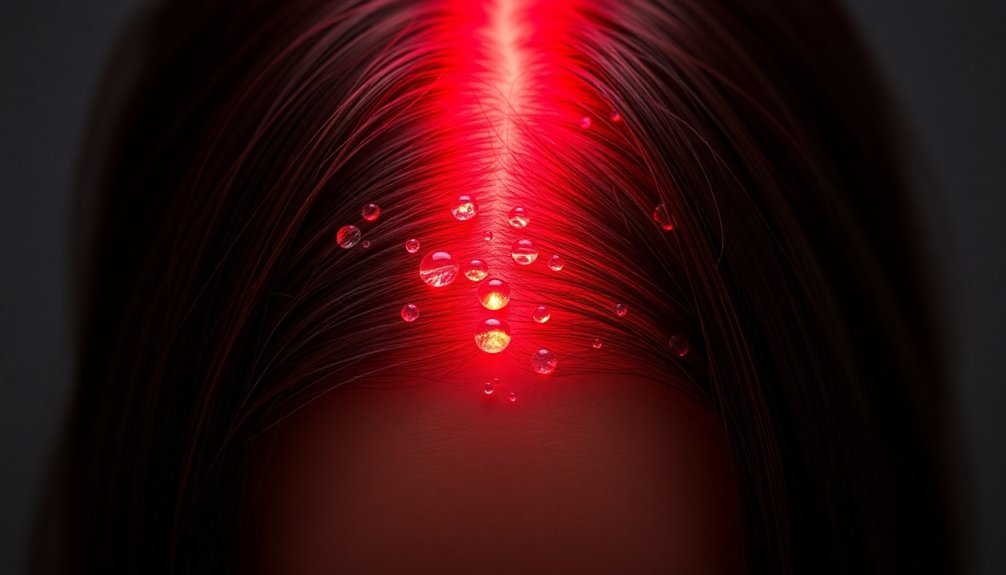
Understanding the safety profile of 660nm red light therapy requires attention to key guidelines and precautions. When using these devices, you'll need to wear appropriate eye protection and guarantee your device meets electrical safety standards.
While FDA clearance indicates basic safety, it's vital to conduct a light sensitivity test before starting regular treatments.
For the best results and safety, follow these core treatment guidelines:
- Keep sessions between 15-20 minutes to avoid overexposure while guaranteeing effectiveness
- Start with treatments every other day, then reduce to 2-3 times weekly after 3-4 months
- Always use the device on clean, dry hair to maximize light penetration
- Choose devices with built-in safety features like sensors that prevent accidental exposure
You can safely combine 660nm treatments with other hair loss solutions like minoxidil. When selecting a device, look for ones operating in the 630-670 nanometer range with sufficient power to penetrate the scalp.
While side effects are rare, some people may experience mild skin reactions. That's why it's critical to use certified devices and follow manufacturer guidelines consistently for the safest, most effective treatment experience.
Frequently Asked Questions
Can I Use 660NM Light Therapy While Taking Hair Growth Medications?
Yes, you can safely use 660nm light therapy while taking hair growth medications. Studies show they work well together, enhancing each other's effects. Just follow recommended dosages and consult your healthcare provider first.
Does Hair Color or Thickness Affect the Effectiveness of 660NM Treatment?
Your hair's color and thickness don't affect how well 660nm treatment works. The treatment targets your hair follicles directly, so you'll see benefits regardless of whether your hair is light, dark, thin, or thick.
Should I Apply Any Products Before Using 660NM Light Therapy?
You don't need to apply any products before 660nm light therapy. While you can combine it with other hair treatments, there's no evidence that pre-treatment products enhance its effectiveness. Focus on consistency instead.
Will 660NM Light Therapy Work on Completely Bald Areas?
You won't see significant results using 660nm light therapy on completely bald areas. It primarily works by stimulating existing hair follicles, so if you've lost all follicles, the treatment's effectiveness will be very limited.
Can Pregnancy or Breastfeeding Women Safely Use 660NM Light Therapy?
Yes, you can safely use 660nm light therapy while pregnant or breastfeeding. Research shows it's non-invasive and poses minimal risk, but it's always best to consult your healthcare provider before starting treatment.
In Summary
You'll find 660nm red light therapy to be a game-changer for your hair growth journey. With its proven ability to boost circulation, reduce DHT levels, and stimulate cellular regeneration, this specific wavelength delivers superior results. Whether you choose at-home devices or professional treatments, you're investing in a safe, science-backed solution. Stick to recommended treatment times and protocols for the best outcome in your hair restoration goals.





Leave a Reply